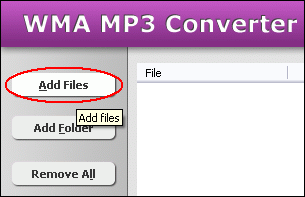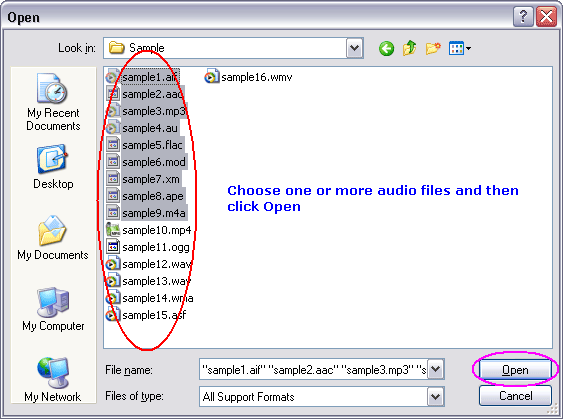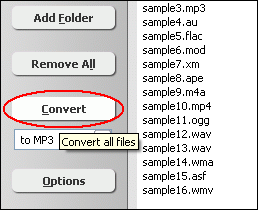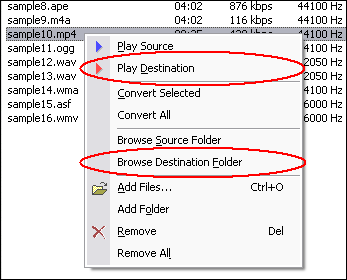MOD to ASFConvert MOD to ASF, MOD to ASF Converter |
 |
| Home | Getting Started | Download | Buy Now! | Screen Shots | FAQ | Support | Contact |
MOD to ASF Converter converts MOD to ASF. The software is an ALL-IN-ONE audio converter that supports more than 100 audio and video files. MOD to ASF Converter supports batch conversion and is full compatible with Vista and Windows 7.
What is MOD? Both MOD and TOD are file-based formats that are stored on a random-access media. Directory structure and naming convention are identical except for extensions of media files. Standard definition video is stored in MPEG-2 program stream container files with MOD extension; in most other systems these files have extension MPG or MPEG. High definition video is stored in MPEG-2 transport stream container files with TOD extension; in most other systems these files have M2T extension. Transport stream files can be converted into more common program stream files without recompressing the video itself. Despite that the file structure is unique to this video recording format, the location for still images follows the standard agreed upon by many still camera manufacturers. Standard definition video can be recorded in 4:3 and 16:9 formats, but the latter is not correctly identified in media file header, so video may appear squeezed horizontally when viewed. Software that is shipped with camcorders is capable of processing aspect ratio correctly by using metadata stored in MOI files. There are also third-party tools for setting the wide-screen flag in media file header. MOD video can be viewed on a computer with a player that is capable of reproducing MPEG-2 video. This video can be easily authored for watching on a DVD player without recompression, because it is fully compliant with DVD-video standard. TOD format is comparable with AVCHD, but cannot be directly played on consumer video equipment. Media files must be packaged into distribution formats like HD DVD or Blu-ray Disc, using authoring software. One of TOD recording modes, "1440CBR", has the same frame size, aspect ratio and frame rate as 1080i HDV, and can be loosely called "HDV on disk". What is ASF? ASF is based on serialized objects which are essentially byte sequences identified by a GUID marker. The format does not specify how (i.e. with which codec) the video or audio should be encoded; it just specifies the structure of the video/audio stream. This is similar to the function performed by the QuickTime, AVI, or Ogg container formats. One of the objectives of ASF was to support playback from digital media servers, HTTP servers, and local storage devices such as hard disk drives. The most common filetypes contained within an ASF file are Windows Media Audio (WMA) and Windows Media Video (WMV). Note that the file extension abbreviations are different from the codecs which have the same name. Files containing only WMA audio can be named using a .WMA extension, and files of audio and video content may have the extension .WMV. Both may use the .ASF extension if desired. ASF files can also contain objects representing metadata, such as the artist, title, album and genre for an audio track, or the director of a video track, much like the ID3 tags of MP3 files. It supports scalable media types and stream prioritization; as such, it is a format optimized for streaming. The ASF container provides the framework for digital rights management in Windows Media Audio and Windows Media Video. An analysis of an older scheme used in WMA reveals that it is using a combination of elliptic curve cryptography key exchange, DES block cipher, a custom block cipher, RC4 stream cipher and the SHA-1 hashing function. ASF container-based media is usually streamed on the internet either through the MMS protocol or the RTSP protocol. MOD to ASF Related Topics: M1A to ASF, WAV to ASF, M4B to ASF, EAC3 to ASF, CD to ASF, ADTS to ASF, FLAC to ASF, MPP to ASF, TTA to ASF, IT to ASF, MIDI to ASF, QCP to ASF, AMR to ASF, RMI to ASF, GSM to ASF, MKA to ASF, WAVE64 to ASF, ULAW to ASF, OGA to ASF, AAC to ASF, KAR to ASF, MO3 to ASF, NSA to ASF, DTS to ASF, AC3 to ASF, AIFF to ASF, CAF to ASF, AWB to ASF, SPX to ASF
|
| Home | Getting Started | Download | Buy Now! | Screen Shots | FAQ | Support | Contact | Links |
| Copyright © 2007-2014 Hoo Technologies All rights reserved. Privacy Policy |





